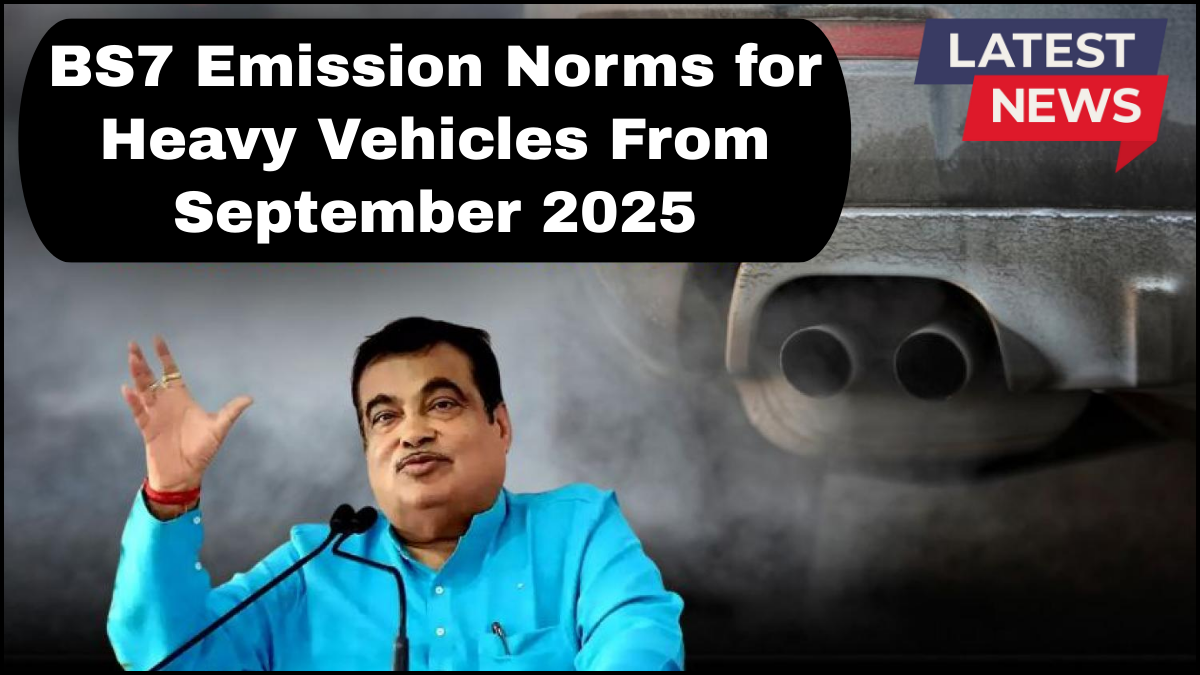Starting September 2025, India will implement the BS7 Norms for Heavy Vehicles, marking a significant shift in the nation’s fight against vehicular pollution. This new emission rule update is designed to push automotive manufacturers toward cleaner technologies while aligning India’s standards with global emission control benchmarks.
Following the earlier Bharat Stage 6 (BS6) regulations introduced in 2020, BS7 norms represent a tighter, more technically demanding standard. These regulations apply to heavy commercial vehicles (HCVs) such as trucks, buses, and other large diesel-powered transport systems that contribute significantly to air pollution, especially in urban and industrial zones.

What Are BS7 Emission Norms?
The BS7 emission norms are India’s upcoming regulatory framework to limit pollutants from internal combustion engines, particularly those used in heavy vehicles. These norms will govern the amount of nitrogen oxides (NOx), particulate matter (PM), hydrocarbons (HC), and carbon monoxide (CO) emitted by vehicles.
Although the final draft of BS7 norms is still being refined, the expected parameters closely mirror Euro VII standards currently under discussion in Europe. This means significantly lower emission thresholds than BS6, with a sharper focus on real-world emissions and not just lab test results.
Key Changes Under BS7 Norms for Heavy Vehicles
Here’s what sets BS7 apart from its predecessor:
1. Stricter Limits on Particulate and NOx Emissions
BS7 will demand even lower emissions of particulate matter (PM) and nitrogen oxides (NOx) — two of the most harmful pollutants linked to respiratory illnesses and smog formation. The limit could go as low as 0.01 g/kWh for PM and 0.4 g/kWh for NOx in some categories.
2. Real Driving Emission (RDE) Testing
Unlike BS6, which still relies heavily on controlled laboratory testing, BS7 introduces RDE testing. This means vehicles will be evaluated under actual road conditions using portable emission measurement systems (PEMS). It’s a major step to ensure that the emissions stay within permissible limits not only in test labs but also during everyday driving.
3. Advanced Onboard Diagnostics (OBD)
OBD systems under BS7 will be far more advanced, capable of monitoring a wider range of components, including the effectiveness of after-treatment systems like Diesel Particulate Filters (DPFs) and Selective Catalytic Reduction (SCR). Fault detection will be more precise, prompting faster repairs and ensuring long-term compliance.
4. Particle Number (PN) Limits
BS7 may introduce stricter PN limits even for larger engine displacements, making it necessary for manufacturers to adopt enhanced DPFs and possibly even electrification or hybrid systems for some vehicle categories.
Industry Impact and Challenges
Implementing the BS7 norms for heavy vehicles won’t be easy. The automotive sector will need to invest heavily in research, development, and manufacturing adjustments. Components such as SCR systems, ammonia slip catalysts, and enhanced EGR (exhaust gas recirculation) technologies are expected to become standard.
Fuel quality will also play a vital role. The sulfur content in diesel fuel must remain extremely low (10 ppm or less) to support the advanced after-treatment systems. This puts pressure not only on vehicle manufacturers but also on refineries and fuel suppliers.
Costs are expected to rise. The addition of sensors, controllers, and emission control hardware could increase the production cost of heavy vehicles by ₹2–4 lakhs, which may ultimately impact logistics and freight rates.
Environmental and Health Benefits
Despite the initial hurdles, the emission rule update 2025 promises long-term gains:
-
Cleaner Air: Lower PM and NOx levels directly translate into reduced urban smog and respiratory illnesses.
-
Climate Impact: With better combustion efficiency and lower hydrocarbon emissions, BS7 can help reduce India’s carbon footprint.
-
Global Alignment: These regulations move India closer to international environmental standards, helping the country position itself as a hub for clean automotive technologies.
Readiness of the Industry
Several OEMs (Original Equipment Manufacturers) have already begun pilot testing BS7-compliant engines. Technology partners are ramping up collaborations to introduce electric turbochargers, dual urea dosing, and hybrid systems that meet the upcoming standards.
Government support, in terms of phased implementation, incentives for R&D, and public-private cooperation, will be crucial to ensuring a smooth transition without disrupting the logistics backbone of the economy.
FAQs
Q1: What is the main objective of BS7 norms for heavy vehicles?
A: The primary goal is to reduce air pollutants like NOx, PM, CO, and HC from heavy-duty vehicles to improve air quality and public health.
Q2: When will the BS7 emission norms come into effect?
A: BS7 norms for heavy vehicles are set to be implemented starting September 2025.
Q3: How is BS7 different from BS6?
A: BS7 includes stricter pollutant limits, introduces real driving emission testing, and requires more advanced onboard diagnostics and emissions monitoring.
Q4: Will BS7 norms apply to older vehicles?
A: No. The BS7 norms will apply to new vehicles sold and registered after the enforcement date. Existing vehicles will continue under previous standards.
Q5: What technologies will be needed to meet BS7 norms?
A: Likely solutions include Diesel Particulate Filters (DPFs), Selective Catalytic Reduction (SCR), Ammonia Slip Catalysts, and more robust Onboard Diagnostic (OBD) systems.
click here to learn more